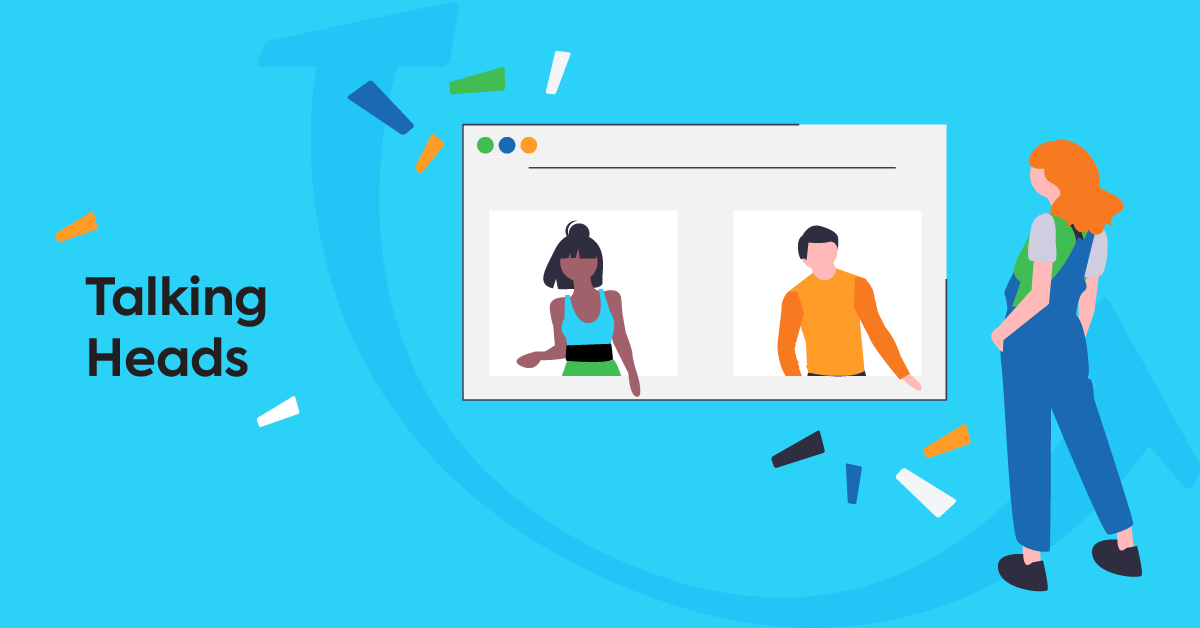Using video for learning has become increasingly popular. And a talking head video is one of the most common types you’ll find in a training course.
Why? Because video is a friendly format that most people associate with both information and entertainment. Particularly for millennials and young professionals, who are used to consuming videos on their mobile devices, video helps with information retention.
So you might want to add videos to your corporate training. But creating videos can feel overwhelming. Where do you even start?
Cue the talking head video.
Even if you don’t have experience in video production, a talking head video is a simple and straightforward solution to use in your training.
Learn how and why you should create this type of training video in our step-by-step guide.
What is a talking head video?
If the phrase “talking head video” brings to mind round-shaped, talking cartoons, guess again. In reality, a talking head video is the simplest video format you can possibly have: a single person, usually an interviewee or a Subject Matter Expert (SME), talking to the camera.
The host can be sitting or standing, although they’re usually only featured up to their chest or waist, so as not to detract attention from their speech. They can either be looking directly to the camera, or to the side as it is accustomed in interviews.
Below you can see some talking head video examples:
This video from Inc., where brain performance expert Jim Kwik shares tips for learning things faster, is a classical example of a talking head video. There isn’t much in terms of graphics or additional content; just the SME, talking straight to the camera.
In this Entrepreneur video, creator & host of The Startup Story James McKinney is interviewing a small business owner. This is a talking head interview that also includes some graphics, mostly bullets of the main points.
Our next example of a talking head video is slightly different. In this Chief Learning Officer video about creating the infrastructure to support lifelong learning, we first see the SME talking through their laptop screen. Throughout the video, the view transitions from the camera laptop to the external camera and vice versa. The effect is subtle, but makes the viewer feel more “immersed”.
A talking head video can be as simple as this. But, with the right video editing skills, and a touch of creativity, you can make something even more engaging. Elena Galli from Starred, for example, is sharing her weekly tips through videos that include special effects, fun backgrounds, and complementary GIFs.
Build interactive online video courses in minutes with TalentLMS
The learning management system that’s easy to set up, easy to use, and easy to customize.
As you can see from these examples, the talking head video technique is a great way to do interviews — and gives SMEs the opportunity to delve into a single topic.
When to use a talking head video for learning
Using a talking head video for learning has many benefits. It can help with both visual learning and social learning. For many, learning by watching another human is easier than reading words on a screen or listening to a voice-over. And because of its pared-down aesthetics, it makes it easier for people to focus on what is being said.
A great benefit of the talking head video format is that it supports microlearning. Microlearning means that the training content is short so that learner engagement doesn’t drop off. A talking head video, as part of your courses, is a simple — and fast — way for SMEs to get their message across.
Another time you want to go the talking head video route is when it comes to onboarding training, especially if you’re onboarding a remote team. Your new employees need to feel connected to the team. Having the CEO and a few team members record short videos (emphasis on “short”) about the company mission and culture will work wonders.
How to create a talking head video
Creating a talking head video is a straightforward process. In contrast to more ambitious video productions, you don’t need special locations, effects, or professional actors.
Here’s a list of the production requirements you’ll need:
- A video script. Although some level of improvisation can be beneficial and produce a more natural result, having a script will be useful. You don’t have to read the script during the presentation or memorize everything, but you can study the content beforehand, rehearse, and use some flash-cards while you record.
- Recording equipment. Ideally, that would be a video camera on a tripod — or two video cameras to capture different angles. Many people however nowadays record talking head videos on their phones or laptops with satisfactory results.
- A boom or lapel microphone. If you’re sitting a few paces away from the camera, you’ll need some help to ensure your sound is crisp. It will also help minimize noise distractions from the background.
- Good lighting. It would be ideal if you have access to natural lighting, as this tends to be the most pleasing to the eyes. But natural light can also shift fast, so especially if you’re doing many takes you’ll need studio lighting. Professional studio lights can be an expensive investment if you only plan to do a few videos. As an alternative, a LED ring light around your phone or camera will also work.
- Your Subject Matter Expert. Obviously, you need an interviewee or an instructor who will do the presentation. (Or yourself!)
- A video-editing software. Use a program to edit the image, sound, speed, and lighting, while also adding and customizing title cards and intro/outro music. There are great professional options such as the Adobe PremierePro or the Final Cut Pro X, but some free programs like OpenShot also yield good results.
- Patience. Creating a talking head video takes time. You’ll probably have to do more “takes” than you expect, especially if you have little or no previous experience recording videos. And although it’s not a technical requirement, patience will make the final result look better.
Meet TalentLibrary™
A growing collection of ready-made video courses that cover the soft skills
your teams need for success at work
![]()

Tips to make a successful talking head video
Now that you’re all set with the basics, it’s time to think of the content of your talking head video — and how to make it more engaging. The tips below will help:
- Rehearse beforehand. This will help you combat nervousness, but will also allow you to listen to what you’re saying and adapt accordingly if something sounds unnatural.
- Start off the camera and then walk into the frame. It will give time for video and audio to start working properly so that you don’t have that awkward pause in the beginning. Don’t worry: you can “cut” your entrance afterward.
- Consider your placement. Traditionally, people on talking head videos are positioned on the center of the screen. But if you position yourself at the left third or the right third of the screen, you leave enough blank space next to you for subtitles and graphics that can be added in post-production.
- Consider shooting with two cameras, placed in opposite corners. This will give you the opportunity to “cut” between different angles later, to make your video more visually stimulating.
- Stick to your time limit. Have a clock that counts backward from your allotted time, so that you don’t end up talking for longer than you have to. As this Training Industry article points out, the best practice is to aim to impart the key messages in 90 seconds.
- Add supportive elements. These will help maintain audience engagement. Supportive elements can be physical, like a whiteboard or cards, or digital like on-screen text, symbols, or sounds that you can add in post-production.
- Link to other resources. When editing the video, you can add hyperlinks to other relevant videos you’ve done, or to material you feel learners should study.
- Add captions. Some people absorb information better when reading, so your talking head video needs to have captions to help them. Captions also give people the opportunity to watch the video with the sound off if they need to — and cater to people with hearing difficulties.
So here it is: your step-by-step guide on how to make a talking head video.
Happy creating!
When you’re ready, hit the record button
As you know by now, there are many benefits to creating a talking head video — and the process is relatively simple.
However, talking head videos also have some disadvantages: when they run too long, learners become disengaged. Plus, the format lacks the interactivity of an instructor-led session, where learners can ask the SME questions in real-time.
But if you combine talking head videos with other training methods and formats, they can become a great addition to your eLearning program.
| Tags: eLearning Videos




